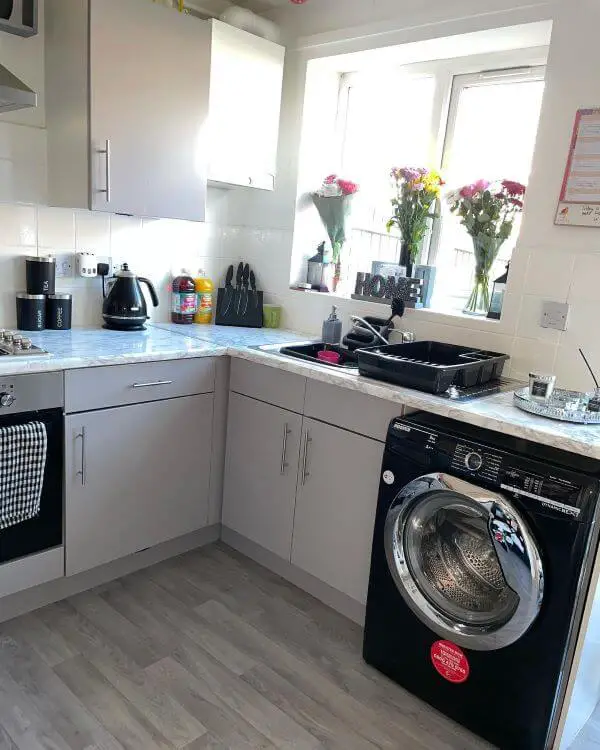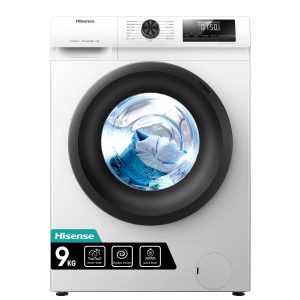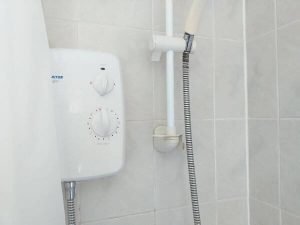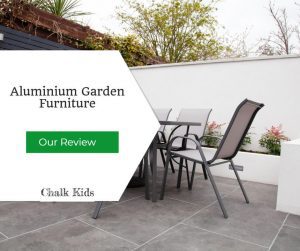In this article we share our best tips on how to heat a cold kitchen, with ideas and help for every budget.
We also go through the most common reasons why your kitchen is cold in the first place.
With peoples energy costs skyrocketing, and many struggling with the “heat or eat” dilemma, this is valuable information.
NB: Since I wrote this post and took the photos the washing machine pictured has stopped working and couldn’t be fixed, Damn it! Anyway I bought a new one which was cheaper than the repairs would have been. You can read about it here: Hisense washing machine review.
Table of Contents
- How best to heat a cold kitchen
- Why is your kitchen always cold?
- Kitchen draft and insulation issues
- Short term solution
- Replace rubber seal around the UPVC door
- Stormguard door seal
- Replacing kitchen door seal
- Why is the Stormguard seal the best?
- No heat source other than cooking
- Why is my kitchen floor so cold?
- How can I make my kitchen warmer?
- Underfloor heating in kitchen
- Electric plinth heater with remote control
- What is a plinth heater?
- Which is the best plinth heater?
- Kitchen Cavity Wall Insulation
- Double glazing for your kitchen
- Wall radiator(s)
How best to heat a cold kitchen
OK so here you have several options and some of them will be more expensive than others.
Assuming you don’t have these things, you could…
| Add cavity wall insulation |
| Add double glazed windows and doors |
| Add a wall radiator if there is space |
| Use a plinth heater (This is what I opted for) |
| Add underfloor heating |
Why is your kitchen always cold?
There can’t be many things less pleasant than coming down in the morning to put the kettle on when your kitchen is freezing cold.
But why is it cold?
There are two basic reasons for a cold kitchen, either poor insulation/draft proofing to protect it from the outside elements or just a lack of non-cooking heat sources.
So only two real problems but there are many potential reasons for the insulation and draft issues.
Without visiting your house, it would be impossible for me to answer your specific question, so let me give some common situations and you may well find that one or more of them will ring a bell with you.
Later in the article we will cover how to deal with many of these problems.
Kitchen draft and insulation issues
A lot of old-style houses, maybe Victorian and Edwardian ones will not have cavity wall insulation and even a lot of post war Semis will not either.
If your kitchen is basically an extension added twenty years ago or more then if it is single brick then it will be an absolute nightmare regarding heat loss.
After build issues the next most obvious thing to consider is basic drafts through poor quality or poorly fitted doors and windows.
If your double glazing is a few years old (and even if it’s not) make sure the rubber seal around the doors and windows isn’t damaged or has bits missing.
See the photo here of a back door that my other half was working on recently. The rubber has perished over the years and you can see gaps where the drafts were coming in. (Well if you can ignore the state of the mess and just concentrate on the door sill)

The customer said that when it rains it actually leaks inside and you can hear the wind whistling through it during the winter months. It needed replacing but the landlord wouldn’t pay the cost of it!

Short term solution
Not ideal but a good thick curtain over the rear door will at least help with the wind. If you have drafty windows then you can try curtains or having shutters fitted to the windows will certainly help.
Replace rubber seal around the UPVC door
Far cheaper than replacing the whole door is just replace the rubber seal. This might sound difficult but actually isn’t as tough as you might think. Anyone with a modicum of DIY skills should be able to do it and here we will explain the basics.
You can buy 25 meres of universal rubber seal for roughly £20 -£25 and that will do all the doors in your house! If it’s just for one door it will be way too much but for that price it will save you more than that on heating bills so it is worth it.
Stormguard door seal
My other half uses Stormguard black rubber door seal most of the time. It is good quality and last a long time.
Just check the size of the gap you need. The one used here is for grooves between 3.2 to 4mm wide. The great thing about this type of seal is their is no glue required, so you can’t get in a mess with it.

Replacing kitchen door seal
Step one is to remove the old rubber seal. This can often prove to be the most difficult part of the process. Luckily on the example we show here it came out almost in one piece. Sometimes though you spend 30 minutes trying to prize the old one out as it continually breaks/snaps off because it becomes brittle with age.
Once its all out clean round the door frame and start to feed the new one in.

Why is the Stormguard seal the best?
The Stormguard UPVC seal is long lasting, it will stop draughts, leaks and will help with outside noise reduction. The noise reduction is usually quite a surprise to people. If you push the door to and listen and then lift the handle as you would to lock it. That pushes the door that extra little bit and you can feel and hear the difference.
It literally seals it air tight. This will reduce noise from outside and of course keep your heat in and the cold air out!
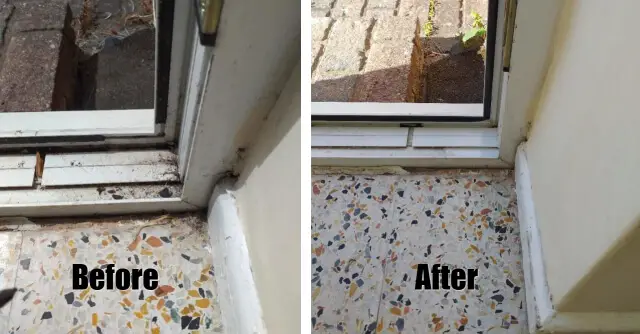
No Door
Other reasons the kitchen gets cold is no internal door. A high percentage of homes don’t have a door between the kitchen and the hall, and this can cause drafts.
No heat source other than cooking
Due to wall space being at a premium in smaller kitchens they often have no radiators at all, and if your house is any real age, it is unlikely to have underfloor heating. This is what causes most of the issues with a kitchen temperature.
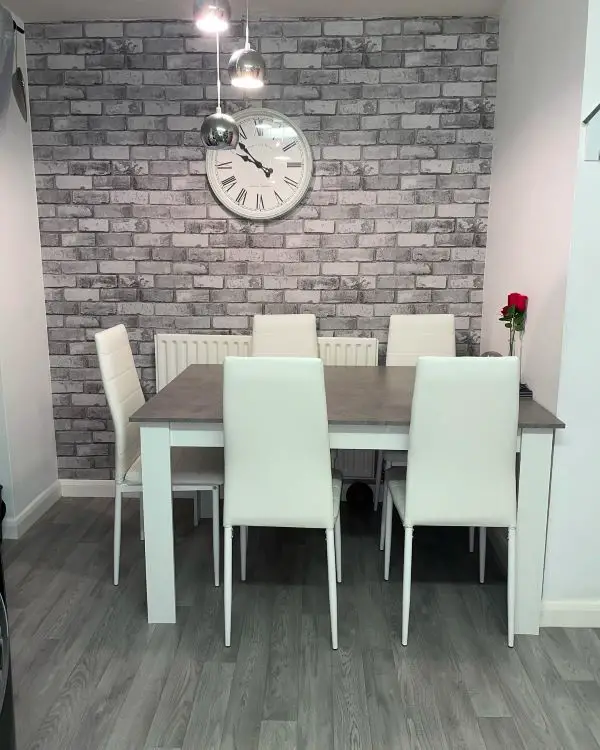
Why is my kitchen floor so cold?
Flooring makes a big difference of course. When it comes to kitchens, we want something practical that can be mopped such as tiles, flags, laminate etc. However, when in bare feet these are usually cold to the touch.
Most people have carpeting in bedrooms and living rooms or at least a rug or mat, so after walking on that and going into the kitchen psychologically it will feel cold even if it isn’t really that bad.
You can buy good kitchen mats at a reasonable cost that not only mean you don’t have to stand directly on the cold floor but offer support if you do stand for long periods in the kitchen while cooking or baking.
How can I make my kitchen warmer?
Underfloor heating, plinth heaters, cavity wall insulation and kitchen radiators are just some options open to you.
In this section of the article, we cover a wide variety of ways you can heat your kitchen.
Underfloor heating in kitchen
This can be reasonably cost effective when building a new house and would certainly be the best option. If you are adding an extension to your property (to be the kitchen) then it may be possible to have underfloor heating to the kitchen without too many issues.
However, to add it to an existing kitchen can be problematic and very costly so I wouldn’t recommend this option.
Electric underfloor is very expensive to run and with the cost of energy prices currently higher than they have ever been it really isn’t viable for most people.
Electric plinth heater with remote control
This is the option I went for as based on price and how relatively easy they are to fit made it the best choice for me.
If you are reading this, it is almost certain you will not have a plinth heater, because you probably wouldn’t have a cold kitchen if you did.
Do not worry if you have no idea what a plinth heater is, we cover that next.
What is a plinth heater?
A plinth heater is a space saving heater which is usually used to either save the space that a traditional wall heater takes up or very often used in a kitchen which doesn’t have any free wall space for a traditional radiator.
Due to their small size and the fact that they do fit under the kitchen units they are less obtrusive than a normal radiator and so help to give your kitchen a smooth sleek look.
There are two types of plinth heater, a “hydronic” one, (hydro means water) which is connected up to your normal gas central heating system like an extra radiator.
This type would normally be fitted by a plumber though if you are handy when it comes to DIY then you could do it yourself.
The second option is the easier one to fit and is an “electric plinth heater”.
As a plinth heater is typically fitted under units, at ground level, the heat starts off at floor level and gently rises. Nice to warm your toes first thing in the morning!
Their simplicity, the fact that compared to other options they are inexpensive to buy and fit and their space saving advantages make a plinth heater a great choice.
Which is the best plinth heater?
If fitting it isn’t an issue, I’d go for the hydro option as long term they will be cheaper to run.
Though it is easier to fit an electric one.
Kitchen Cavity Wall Insulation
If your house has cavity walls, then getting them insulated properly will really improve the energy efficiency of your home.
It does need to be done by an expert and the price isn’t cheap, but some councils offer grants to help with the cost.
One thing is certain it will help retain heat in your home thereby reducing heating bills by several hundred pounds a year once the work is carried out.
Double glazing for your kitchen
It goes without saying that replacing old single glazed doors and windows with modern double-glazed replacements will have a big heat saving effect.
Often old frames are like a collider letting out heat at a huge rate.
Wall radiator(s)
Wall space is often at a premium in kitchens so having free wall space to retro-fit a radiator is sometimes not an option.
When you do have space, how easy would it be to have an additional radiator connected up to your central heating system?
Read the latest posts here:
- Can I Run a Business from my Shed?So, can I run a business from my shed in 2024? Well, the simple answer is yes you can, but there are some things you must consider. There are issues that could cause you problems and may in certain circumstances, disqualify you from running a business from home. When it comes to the law the …
- Which is the best Capital on Tap Promo Code?Here is a Capital on Tap promo code: 2REFC237G71 that will allow you to get £75 credited to your account to spend as you wish.
- Why Are Beds So Comfortable? Unraveling the Secrets of Cozy SlumberAs someone who knows the value of a good night’s sleep, I’ve always been fascinated by the comfort that beds provide. From plush pillows to soft sheets, there’s no denying the appeal of sinking into a cozy bed after a long day. But have you ever wondered what makes beds so comfortable? As it turns …
Why Are Beds So Comfortable? Unraveling the Secrets of Cozy Slumber Read More »
- Why is the Word Bed Shaped Like a Bed? Discover the Reason!Have you ever stopped to wonder why the word “bed” is shaped like the object it represents? As a professional copywriting journalist, I have always been fascinated by the relationship between word shapes and their meanings. In this article, we will explore the intriguing mystery of why the word “bed” is shaped like a bed. …
Why is the Word Bed Shaped Like a Bed? Discover the Reason! Read More »
- Do You Give Up Your Bed for Guests? Tips & Etiquette GuideWelcome to my guide on hosting guests in your home! One of the most common dilemmas we face when we have visitors staying over is whether or not to give up our own bed. It can be challenging to balance hospitality with personal comfort, but with the right mindset and some practical tips, you can …
Do You Give Up Your Bed for Guests? Tips & Etiquette Guide Read More »
- Can You Do Sit Ups in Bed? Discover the Answer Today!As someone who loves to exercise and stay fit, I’m always looking for new ways to incorporate physical activity into my daily routine. Recently, I’ve been wondering if it’s possible to do sit-ups in bed. After all, it’s comfortable and convenient, and I’m all for making exercise as accessible as possible. So, can you do …
Can You Do Sit Ups in Bed? Discover the Answer Today! Read More »
- Hisense washing machine reviewHey there, I recently got my hands on the Hisense-WFQP9014EVM Freestanding 9 KG Front Load Washing Durable Inverter Machine and I’m excited to share my thoughts with you. This washing machine has some impressive features that make laundry day a breeze. So, let’s dive in! Pros and Cons What We Liked What Can Be Improved …
- Shower head leaking at threadsMy leaking shower head is driving me nuts. You can see a short video of it here A leaking shower head is frustrating for anyone especially if you have it constantly dripping even when the shower isn’t in use. Fortunately for me, mine only drips when I’m actually using the shower so at least I’m …
- What is the purpose of a desk mat?A desk mat protects your desk from scratches and stains, reduces noise from typing or moving objects, offers a smooth surface for comfortable writing and accurate mouse movement, and adds aesthetic appeal to your workspace. Understanding the Purpose of a Desk Mat Desk mats have tons of uses! They protect desk surfaces, muffle keyboard typing, …
- Purple Birds Unveiled: Discovering Nature’s Purple BeautiesAre you ready to embark on a journey into the amazing world of purple birds, where beauty and intrigue collide? We reveal the secrets of their enchanting plumage. Discover why their captivating presence is worth celebrating and preserving for generations to come. Introduction to Purple Birds Purple birds have long captivated the hearts and imaginations …
Purple Birds Unveiled: Discovering Nature’s Purple Beauties Read More »
- Limited Company Credit Cards: 9 things you need to knowHere we look in some detail at your options when it comes to Limited Company credit cards, and LLP credit cards. We will answer the most commonly asked questions. We will cover the difference between company and personal credit cards and answer things you want to know about eligibility checks, interest free cards, using a …
Limited Company Credit Cards: 9 things you need to know Read More »
- What are the odds of a Bunk Bed breaking?It is difficult to determine the exact odds of a bunk bed breaking because it depends on many factors. Though if used properly/sensibly then the odds are millions to one. On the other hand if you have heavy children or full grown adults bouncing around on them and treating them like a climbing frame in …
- Best Touchscreen Winter GlovesThe best winter touch screen gloves are designed to be worn in cold weather but still allow you to use your smartphone or tablet, while still wearing them. Let’s be honest the last thing you want to do when it’s freezing cold is take your gloves off to read or reply to a text or …
- Best Clothes for Dog WalkingOn winter evenings when it’s dark by 5pm, and snowing outside, it’s tempting to just stay indoors and hibernate. In the summer, when it’s hot and sultry, it can be difficult to summon up the energy to go for a walk too. Unfortunately, those of us who are dog owners don’t have that luxury. After …
- What are the best 10 types of flowers to say sorry?Here are 10 flowers that we recommend to give, to express apologies: Why roses are best to say sorry with Roses are a classic choice for expressing a variety of sentiments, including apologies. They are often associated with love, beauty, and passion, making them a suitable gift for expressing regret and asking for forgiveness. The …
What are the best 10 types of flowers to say sorry? Read More »
- How to Heat a Cold KitchenIn this article we share our best tips on how to heat a cold kitchen, with ideas and help for every budget. We also go through the most common reasons why your kitchen is cold in the first place. With peoples energy costs skyrocketing, and many struggling with the “heat or eat” dilemma, this is …
- Electrical Safety for a Secure HomeWe depend on electricity to keep us entertained, make our lives easier and stay in touch with friends and family around the world. Still, it’s a very powerful force that shouldn’t be taken lightly. Even though modern safety regulations have helped make electricity easier to use and safer to have in the home, it can …
- How Many Clothes Does a 7-Year-Old Need?Buying clothes for a child can be pretty tough. After all, they grow so quickly. No sooner have you started to put together a decent collection of outfits for them, they have suddenly outgrown them, and they need a completely new set. So, how many clothes does a 7-year-old need? In an ideal world, a …
- Can Cavapoos Be Left Alone?The small and hypoallergenic Cavapoo seems like an adorable choice for a companion, but if you are someone with a busy lifestyle, you may worry about how the dog will fare when you are not home. Cavapoos can be left alone for up to 5 or 6 hours, but they can suffer from separation anxiety …
- Is Going Hiking with a Guy a Date?There are many rules and conditions in dating, especially when the relationship first begins. What compounds awkwardness is when you’re on the fence with male friends. Then the lines become blurry and deciphering what constitutes a “date” can misconstrue for a hangout and vice versa. One such scenario is hiking. So, is going hiking with …
- Credit Card FAQ’sCredit cards are necessary in today’s society. They help pay for things that you may be low on cash for and allow you to make purchases from a distance, such as shopping online. But, if you’re new to having a credit card, you probably have several questions about using it. The article below details some …
- Bangkok MemoriesBangkok in Thailand is a city that creates memories, so if you are thinking of visiting this great city I thought sharing my memories might help inspire you. In Thai language, Bangkok has according to the Guinness Book of Records the longest city name in the world. ‘Krungthepmahanakhon Amonrattanakosin Mahintharayutthaya Mahadilokphop Noppharatratchathaniburirom Udomratchaniwetmahasathan Amonphimanawatansathit Sakkathattiyawitsanukamprasit’ …
- What are the Best Maternity LeggingsDiscover the Best Maternity Leggings 2023, for ultimate comfort and style during pregnancy. Get perfect fit and support for your bump with our comprehensive guide. I’ve updated this article with my latest research on the “best maternity leggings 2023″. When I was pregnant, I really needed to buy some comfortable clothes, so I thought I’d …
- Is Aluminium Good for Garden Furniture?A home’s outdoor space is much more beautiful and relaxing when furniture is available for family and friends. But, you want to ensure you choose the right kind so that it lasts for as long as possible while providing comfort and aesthetics. There is a plethora of materials out there and metals are often the …
- Stone Painting Kits: The 5 things you must know, revealed.Today we’re going to explain all that you need to know, to be able to create your own stone painting kits. As well as give you the important steps to be able to do it yourself. Also we’ll share some project ideas to get those inspirational juices flowing. Painting stones is a fun form of …
Stone Painting Kits: The 5 things you must know, revealed. Read More »
